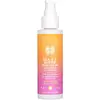What's inside
What's inside
 Key Ingredients
Key Ingredients

 Benefits
Benefits

 Concerns
Concerns

 Ingredients Side-by-side
Ingredients Side-by-side

Octocrylene 2.9%
UV AbsorberWater
Skin ConditioningButyloctyl Salicylate
Skin ConditioningCoconut Alkanes
EmollientCalcium Sodium Borosilicate
Cetearyl Alcohol
EmollientParfum
MaskingPropanediol
SolventAscorbic Acid
AntioxidantTocopherol
AntioxidantAscophyllum Nodosum Extract
Skin ConditioningAlgae Extract
EmollientWithania Somnifera Root Extract
Skin ConditioningAloe Barbadensis Leaf Juice
Skin ConditioningCaffeine
Skin ConditioningCaprylhydroxamic Acid
Caprylyl Glycol
EmollientCellulose Gum
Emulsion StabilisingCoco-Caprylate/Caprate
EmollientCoco-Glucoside
CleansingEthyl Ferulate
AntioxidantFructose
HumectantGlycerin
HumectantGlyceryl Stearate
EmollientLauroyl Lysine
Skin ConditioningMicrocrystalline Cellulose
AbsorbentSodium Gluconate
Skin ConditioningSodium Stearoyl Glutamate
CleansingXanthan Gum
EmulsifyingOctocrylene 2.9%, Water, Butyloctyl Salicylate, Coconut Alkanes, Calcium Sodium Borosilicate, Cetearyl Alcohol, Parfum, Propanediol, Ascorbic Acid, Tocopherol, Ascophyllum Nodosum Extract, Algae Extract, Withania Somnifera Root Extract, Aloe Barbadensis Leaf Juice, Caffeine, Caprylhydroxamic Acid, Caprylyl Glycol, Cellulose Gum, Coco-Caprylate/Caprate, Coco-Glucoside, Ethyl Ferulate, Fructose, Glycerin, Glyceryl Stearate, Lauroyl Lysine, Microcrystalline Cellulose, Sodium Gluconate, Sodium Stearoyl Glutamate, Xanthan Gum
Butyl Methoxydibenzoylmethane 3%
UV AbsorberHomosalate 15%
Skin ConditioningEthylhexyl Salicylate 5%
UV AbsorberOctocrylene 10%
UV AbsorberWater
Skin ConditioningCetyl Palmitate
EmollientHydrated Silica
AbrasiveAcrylates/C12-22 Alkyl Methacrylate Copolymer
Caprylyl Methicone
Skin ConditioningStyrene/Acrylates Copolymer
Cetyl Dimethicone
EmollientGlyceryl Stearate
EmollientPEG-100 Stearate
Polyester-8
Skin ConditioningTrideceth-6
EmulsifyingDimethicone
EmollientEthylhexyl Stearate
EmollientParfum
MaskingPhenoxyethanol
PreservativeDimethyl Capramide
Emulsion StabilisingSodium Polyacrylate
AbsorbentTrimethylsiloxysilicate
EmollientXanthan Gum
EmulsifyingBHT
AntioxidantDipotassium Glycyrrhizate
HumectantTocopheryl Acetate
AntioxidantEthylhexylglycerin
Skin ConditioningTetrasodium Glutamate Diacetate
Butyl Methoxydibenzoylmethane 3%, Homosalate 15%, Ethylhexyl Salicylate 5%, Octocrylene 10%, Water, Cetyl Palmitate, Hydrated Silica, Acrylates/C12-22 Alkyl Methacrylate Copolymer, Caprylyl Methicone, Styrene/Acrylates Copolymer, Cetyl Dimethicone, Glyceryl Stearate, PEG-100 Stearate, Polyester-8, Trideceth-6, Dimethicone, Ethylhexyl Stearate, Parfum, Phenoxyethanol, Dimethyl Capramide, Sodium Polyacrylate, Trimethylsiloxysilicate, Xanthan Gum, BHT, Dipotassium Glycyrrhizate, Tocopheryl Acetate, Ethylhexylglycerin, Tetrasodium Glutamate Diacetate
 Reviews
Reviews

Ingredients Explained
These ingredients are found in both products.
Ingredients higher up in an ingredient list are typically present in a larger amount.
Glyceryl Stearate is a mix of glycerin and stearic acid.
It is used to stabilize the mixing of water and oil ingredients. By preventing these ingredients from separating, it can help elongate shelf life. It can also help thicken the product's texture.
As an emollient, it helps soften skin and supports barrier-replenishing ingredients.
In cosmetics, Glyceryl Stearate is often made from vegetable oils or synthetically produced.
This ingredient may not be fungal-acne safe
Fun fact: The human body also creates Glyceryl Stearate naturally.
Learn more about Glyceryl StearateOctocrylene protects skin from sun damage. It absorbs UV-B with peak absorption of 304 nm. It is a common sunscreen ingredient and often paired with avobenzone, a UVA filter. This is because octocrylene stabilizes other sunscreen ingredients by protecting them from degradation when exposed to sunlight. Octocrylene is a photostable ingredient and loses about 10% of SPF in 95 minutes.
Octocrylene also acts as an emollient, meaning it helps skin retain moisture and softens skin. It is oil-soluble and hydrophobic, enhancing water-resistant properties in a product.
Those who are using ketoprofen, a topical anti-inflammatory drug, may experience an allergic reaction when using octocrylene. It is best to speak with a healthcare professional about using sunscreens with octocrylene.
The EU allows a maximum of these concentrations:
Learn more about OctocryleneParfum is a catch-all term for an ingredient or more that is used to give a scent to products.
Also called "fragrance", this ingredient can be a blend of hundreds of chemicals or plant oils. This means every product with "fragrance" or "parfum" in the ingredients list is a different mixture.
For instance, Habanolide is a proprietary trade name for a specific aroma chemical. When used as a fragrance ingredient in cosmetics, most aroma chemicals fall under the broad labeling category of “FRAGRANCE” or “PARFUM” according to EU and US regulations.
The term 'parfum' or 'fragrance' is not regulated in many countries. In many cases, it is up to the brand to define this term.
For instance, many brands choose to label themselves as "fragrance-free" because they are not using synthetic fragrances. However, their products may still contain ingredients such as essential oils that are considered a fragrance by INCI standards.
One example is Calendula flower extract. Calendula is an essential oil that still imparts a scent or 'fragrance'.
Depending on the blend, the ingredients in the mixture can cause allergies and sensitivities on the skin. Some ingredients that are known EU allergens include linalool and citronellol.
Parfum can also be used to mask or cover an unpleasant scent.
The bottom line is: not all fragrances/parfum/ingredients are created equally. If you are worried about fragrances, we recommend taking a closer look at an ingredient. And of course, we always recommend speaking with a professional.
Learn more about ParfumWater. It's the most common cosmetic ingredient of all. You'll usually see it at the top of ingredient lists, meaning that it makes up the largest part of the product.
So why is it so popular? Water most often acts as a solvent - this means that it helps dissolve other ingredients into the formulation.
You'll also recognize water as that liquid we all need to stay alive. If you see this, drink a glass of water. Stay hydrated!
Learn more about WaterXanthan gum is used as a stabilizer and thickener within cosmetic products. It helps give products a sticky, thick feeling - preventing them from being too runny.
On the technical side of things, xanthan gum is a polysaccharide - a combination consisting of multiple sugar molecules bonded together.
Xanthan gum is a pretty common and great ingredient. It is a natural, non-toxic, non-irritating ingredient that is also commonly used in food products.
Learn more about Xanthan Gum